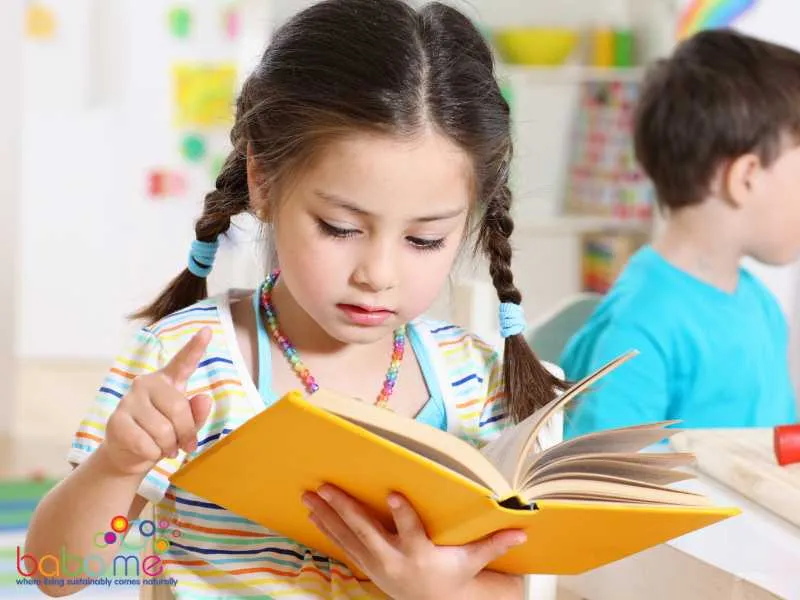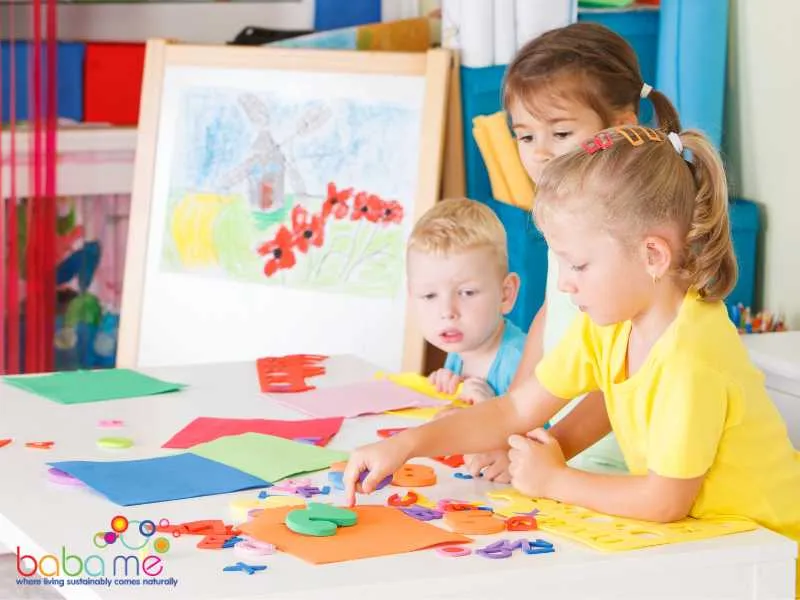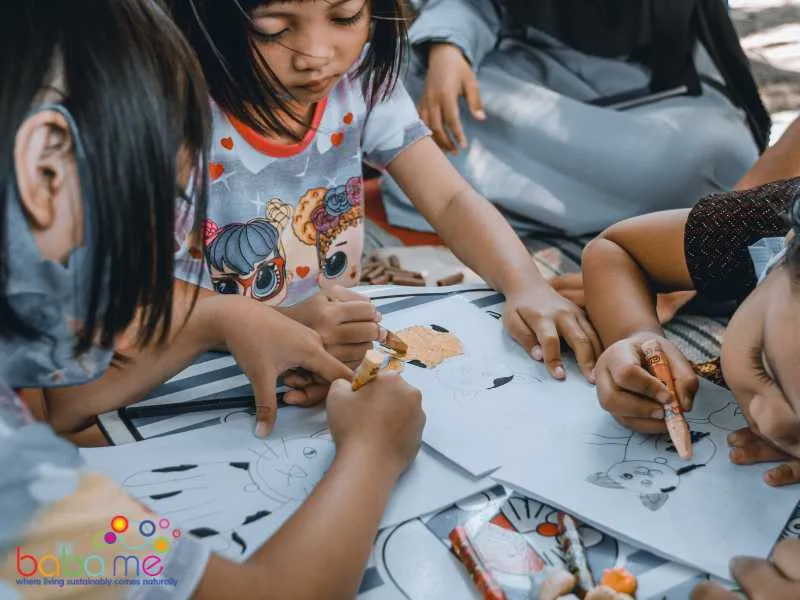Parallel Play is more than just a developmental term; it represents a fundamental stage in a child’s social growth. Understanding Parallel Play is pivotal for grasping early childhood interactions because it marks a crucial transitional phase in a child’s journey from solitary to social play.
At its essence, Parallel Play refers to the behavior observed in children, typically between the ages of 2 to 3, where they play alongside other children but do not engage in direct play interactions with each other. While it might seem as if each child is engrossed in their own world, this stage serves multiple purposes:
- Observation and Learning: Children observe their peers, learning skills and mimicking behaviors.
- Transition to Social Interactions: It provides a safe space for children to get accustomed to the presence of peers without the pressure of direct interaction.
- Fostering Independence: Children practice skills and problem-solve on their own, even while in a social setting.
Curious about the deeper implications and the subsequent stages following Parallel Play? Dive deeper with us as we navigate the fascinating world of childhood play, illuminating the importance of each phase in shaping a child’s social trajectory.
Key Takeaways on What is Parallel Play
- Parallel Play is a play development stage where young children play side by side with peers, using similar toys, in a similar manner, but without much interaction or collaboration.
- Parallel play stands as a bridge between solitary play and more interactive forms of play. Children in this phase are often seen playing next to each other, mirroring each other’s actions, yet not directly engaging with one another.
- Parallel play plays a pivotal role in a child’s journey towards social development. While it might seem like children are uninvolved with each other, they are actively observing, learning, and laying the groundwork for future interactive play stages.
- During parallel play, children keenly observe their peers, absorbing new ways to use toys, emulate behaviors, and understand the dynamics of play. This observational learning enriches their play repertoire and boosts cognitive development.
- Parallel play encourages children to explore and enjoy their own company, fostering independence. They learn to entertain themselves and derive satisfaction from their own activities, which is crucial for building self-reliance.
- Parallel play is often a precursor to associative and cooperative play stages. As children become more comfortable and confident in their play environment, they naturally progress to more interactive forms of play, enhancing their social skills and collaborative abilities.
Definition of Parallel Play
Parallel play refers to a stage of child development where children play alongside each other without engaging in direct interaction or cooperation. Often observed in toddlers and preschoolers, this form of play might seem like children are in their own worlds, but it’s a significant step in their social and cognitive development.
During parallel play, children might be doing similar activities or playing with similar toys as their peers, but each remains absorbed in their own task.
This stage is crucial as it bridges the gap between solitary play and more interactive, cooperative play forms. While children engaged in parallel play might not be directly interacting with each other, they are acutely aware of their peers’ presence.
This awareness lays the foundation for understanding social cues, sharing, and eventually, cooperative play. For instance, a child might observe another child building a tower with blocks and decide to build their own, even if they don’t communicate about it.
Parents and educators can support children during this stage by providing ample opportunities for parallel play. Setting up play stations with similar sets of toys or materials can encourage this behavior. Over time, as children become more comfortable and their social skills develop further, they naturally progress to more interactive forms of play, building on the foundations laid during the parallel play stage.

Importance of Parallel Play
The significance of parallel play, as delineated by Mildred Parten’s Six Stages of Play, is deeply intertwined with the broader spectrum of a child’s social development. Positioned between solitary and associative play, parallel play emerges as a bridge that supports children in their transition from individual play to more socially involved activities.
Within the progression proposed by Parten, parallel play offers children a unique opportunity to be in close proximity to their peers without the immediate need for interaction. While engaging in this form of play, children might be playing side by side, using similar toys or materials, yet each remains engrossed in their own world.
This stage acts as a safe haven, allowing children to observe, process, and gradually understand the dynamics of social interactions. They begin to pick up subtle cues, emulate behaviors, and develop an awareness of how peers approach play, all without the pressure of direct engagement.
In the grand tapestry of child development, parallel play holds a pivotal role. It lays the foundational stones for future social interactions and collaborative endeavors. By allowing children the space to observe and be observed, it nurtures a sense of belonging, fosters confidence, and prepares them for the subsequent stages of associative and cooperative play.
Mildred Parten’s Six Stages of Play – What is the parallel play stage?
Parallel play, often observed in the toddler years (around ages 2-3), is a stage of child development where children play adjacent to each other, but not with each other. This type of play is a step towards more complex social interactions or group play.
Mildred Parten defined six stages of play development as children progress:
| Stage of Play | Age Range | Description |
|---|---|---|
| Unoccupied Play | 0-2 years | During this stage, children are relatively stationary and their play appears scattered. They may engage with whatever is near, exploring and observing their environment. |
| Solitary (Independent) Play | 2-3 years | Children play alone and independently, even if surrounded by others. Their focus is on their activity, not what others are doing. |
| Onlooker Play | 2.5-3.5 years | Children watch others play. They may engage in conversation but not join in the play. This stage helps children learn more about social norms and rules. |
| Parallel Play | 2.5-3.5 years | Children play separately but close to each other, often mimicking each other’s actions. It’s a pivotal stage where they begin to notice others and start to experiment with social interaction. |
| Associative Play | 3-4 years | In this stage, children start to interact more with each other in their play. They may share toys and converse about their play, but there’s no organized activity or common goal. |
| Cooperative Play | 4+ years | Children now start to play together towards a shared goal. This is the most social stage of play, involving cooperation, problem-solving, and negotiation. |

Benefits of Parallel Play
Parallel play, where children play alongside each other but not necessarily with each other, is a normal and important step in a child’s development. Here are some benefits of parallel play:
1. Parallel Play Develops Social Skills
Parallel play, often observed in young children playing side-by-side without direct interaction, significantly contributes to the development of social skills. As children mirror each other’s actions during parallel play, they subtly understand and acknowledge their peers’ actions and intentions, laying foundational blocks for empathy and future complex social interactions as well as improved language development.
This stage of play serves as a bridge, helping children transition from independent activities to more collaborative forms of play, fostering awareness, empathy, and confidence in social environments.
2. Parallel Play Enhances Creativity and Imagination
Parallel play plays a pivotal role in enhancing creativity and imagination. In this form of play, children draw inspiration from their peers’ actions, expanding their imaginative horizons without direct interaction. The subtle observation of a peer’s imaginative scenarios encourages them to explore new narratives and ideas, nurturing a creative mindset that aids in diverse problem-solving and innovative thinking later in life.
3. Parallel Play Builds Self-Confidence
Parallel play serves as a foundation for building self-confidence. During this play, children have the autonomy to choose and navigate their tasks, leading them to trust their abilities and decisions. Observing peers nearby while remaining engrossed in their own endeavors reinforces their sense of independence and self-assurance, setting the stage for confident interactions in future group settings.
4. Parallel Play Develops Spatial Awareness
Parallel play promotes spatial awareness as children independently manipulate objects, gauge distances, and discern relationships between items in their surroundings. Engaging in these solo explorations helps children cultivate an intuitive understanding of space, depth, and dimension, proving instrumental for their cognitive growth in the future.
5. Parallel Play Enhances Cognitive Development
Parallel play acts as a catalyst for cognitive development in toddlers. By engaging in activities alongside peers without direct interaction, children not only refine their spatial awareness but also foster problem-solving skills and creativity. This independent exploration shapes their understanding of cause and effect, laying a foundation for complex cognitive tasks and interactions in later stages of growth.

Activities for Promoting Parallel Play
Promoting parallel play can be achieved by introducing activities that allow children to play independently while being in close proximity to one another. One effective activity to promote parallel play is setting up art stations where each child has their own set of crayons, paints, and paper.
As children create their masterpieces, they often glance over at their peers, drawing inspiration from them or simply acknowledging their presence, all while remaining engrossed in their own work.
Another fruitful activity involves building stations with blocks or construction toys. When each child has access to their own set of building materials, they can construct their own structures side by side. This not only promotes creativity but also allows children to observe and learn from their peers’ building techniques without directly interacting. Playdough or clay stations function similarly, where children can mold and shape their own creations while sitting next to each other.
Setting up a pretend play corner with dress-up costumes or a mini kitchen set can also encourage parallel play. Children can engage in their own imaginative scenarios, like cooking or going on an adventure, all while being aware of their peers playing alongside them.
As they immerse themselves in their individual stories, they often draw parallel narratives inspired by their friends, showcasing the subtle influence of parallel play.

Parallel Play in Education
Parallel play in education offers a unique approach to learning and development. Within classroom settings, educators have noticed that when children are engaged in parallel play, they often mimic or mirror the activities of their peers, albeit without direct interaction. This mirroring can be a powerful tool for teachers, as it allows students to observe and learn from one another, fostering a sense of independence and self-directed learning.
Incorporating parallel play into educational settings can be especially beneficial for students who might be hesitant or shy about direct interaction. By observing their peers, these students can pick up new skills, ideas, or methods without the pressure of active collaboration.
For example, during art class, two students might be working on separate projects side by side. While they may not be collaborating directly, one student might observe a technique used by the other and decide to incorporate it into their own work.
Educators can harness the power of parallel play by setting up environments conducive to this type of interaction. Arranging desks or workstations so that students can easily observe one another, providing similar materials or prompts, and allowing time for independent exploration can all encourage parallel play.
In doing so, teachers create an environment where students learn not just from the instructor, but also from each other, promoting a holistic and inclusive educational experience.
FAQS on Parallel Play Skills
Why is parallel play important for preschool children?
Parallel play is a significant milestone in a child’s social development. It allows children to progress from individual play to playing alongside others. This stage supports children’s behavior understanding as they learn from observing each other.
How can I support parallel play?
Parents play a vital role in fostering parallel play and a child’s development. By arranging play dates or setting up parallel play activities like having two or more children draw at the same table or play with separate sets of blocks in the same room, parents can encourage this developmental stage.
What are parallel play activities?
Parallel play activities could involve two toddlers playing separately in a sandbox, each with their own toys, or children using different pieces of playground equipment in the same area.




